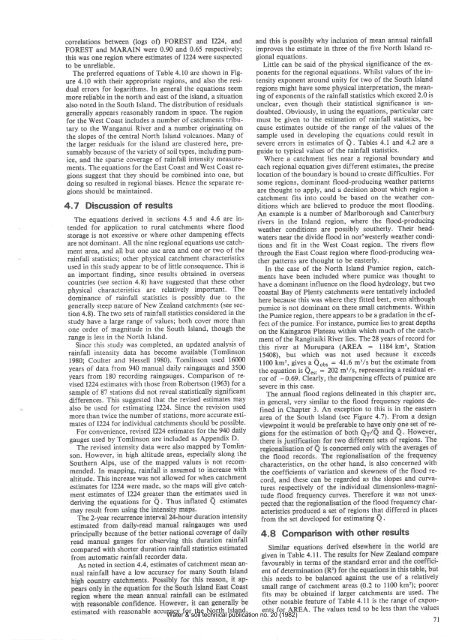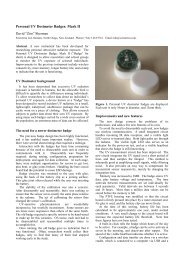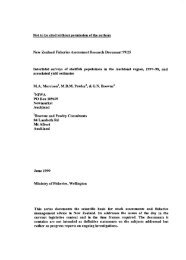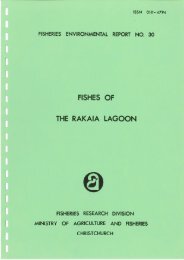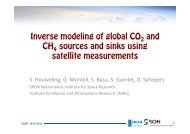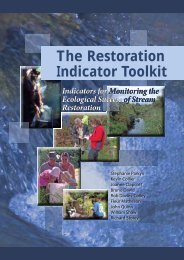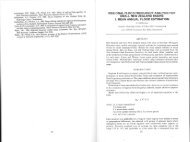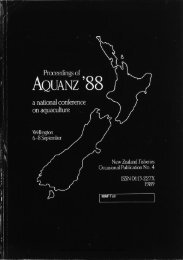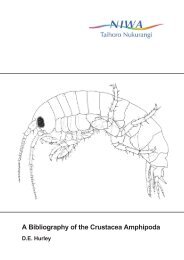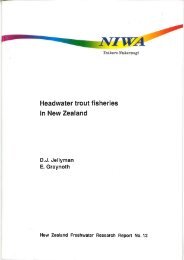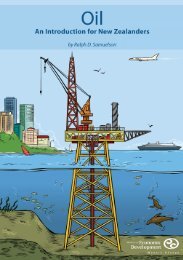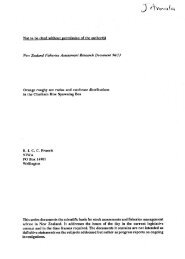WATER & SOIL - These are not the droids you are looking for.
WATER & SOIL - These are not the droids you are looking for.
WATER & SOIL - These are not the droids you are looking for.
You also want an ePaper? Increase the reach of your titles
YUMPU automatically turns print PDFs into web optimized ePapers that Google loves.
correlations between (logs oÐ FOREST and 1224, and<br />
FOREST and MARAIN were 0.90 and 0.65 respectively;<br />
this was one region where estimates of l2?A were suspected<br />
to be unreliable.<br />
The preferred equations of Table 4.10 <strong>are</strong> shown in Figure<br />
4.10 with <strong>the</strong>ir appropriate regions, and also <strong>the</strong> residual<br />
errors <strong>for</strong> logarithms. In general <strong>the</strong> equations seem<br />
more reliable in <strong>the</strong> north and east of <strong>the</strong> island, a situation<br />
also <strong>not</strong>ed in <strong>the</strong> South Island. The distribution ofresiduals<br />
generally appears reasonably random in space. The region<br />
<strong>for</strong> <strong>the</strong> West Coast includes a number of catchments tributary<br />
to <strong>the</strong> Wanganui River and a number originating on<br />
<strong>the</strong> slopes of <strong>the</strong> central North Island volcanoes. Many of<br />
<strong>the</strong> larger residuals <strong>for</strong> <strong>the</strong> island <strong>are</strong> clustered here, presumably<br />
because of <strong>the</strong> variety of soil types, including pumice,<br />
and <strong>the</strong> sparse coverage of rainfall intensity measurements.<br />
The equations <strong>for</strong> <strong>the</strong> East Coast and West Coast regions<br />
suggest that <strong>the</strong>y should be combined into one, but<br />
doing so resulted in regional biases. Hence <strong>the</strong> separate regions<br />
should be maintained.<br />
4.7 Discussion of results<br />
The equations derived in sections 4.5 and 4.6 <strong>are</strong> intended<br />
<strong>for</strong> application to rural catchments where flood<br />
storage is <strong>not</strong> excessive or where o<strong>the</strong>r dampening effects<br />
<strong>are</strong> <strong>not</strong> dominant. All <strong>the</strong> nine regional equations use catchment<br />
<strong>are</strong>a, and all but one use <strong>are</strong>a and one or two of <strong>the</strong><br />
rainfall statistics; o<strong>the</strong>r physical catchment characteristics<br />
used in this study appear to be of little consequence. This is<br />
an important finding, since results obtained in overseas<br />
countries (see section 4.8) have suggested that <strong>the</strong>se o<strong>the</strong>r<br />
physical characteristics <strong>are</strong> relatively important. The<br />
dominance of rainfall statistics is possibly due to <strong>the</strong><br />
generally steep nature of New Zealand catchments (see section<br />
4.8). The two sets of rainfall statistics considered in <strong>the</strong><br />
study have a large range of values; both cover more than<br />
one order of magnitude in <strong>the</strong> South Island, though <strong>the</strong><br />
range is less in <strong>the</strong> North Island.<br />
Since this study was completed, an updated analysis of<br />
rainfall intensity data has become available (Tomlinson<br />
1980; Coulter and Hessell 1980). Tomlinson used 16000<br />
years of data from 940 manual daily raingauges and 3500<br />
years from 180 recording raingauges. Comparison of revised<br />
1224 estimates with those from Robertson (1963) <strong>for</strong> a<br />
sample of 87 stations did <strong>not</strong> reveal statistically significant<br />
differences. This suggested that <strong>the</strong> revised estimates may<br />
also be used <strong>for</strong> estimating 1224. Sirce <strong>the</strong> revision used<br />
more than twice <strong>the</strong> number of stations, more accurate estimates<br />
of 1224 lor individual catchments should be possible.<br />
For convenience, revised 1224 estimates <strong>for</strong> <strong>the</strong> 94O daily<br />
gauges used by Tomlinson <strong>are</strong> included as Appendix D.<br />
- The revised intensity data were also mapped by Tomlinson.<br />
However, in high altitude <strong>are</strong>as, especially along <strong>the</strong><br />
Sou<strong>the</strong>rn Alps, use of <strong>the</strong> mapped values is <strong>not</strong> recommended.<br />
In mapping, rainfall is assumed to increase with<br />
altitude, This increase was <strong>not</strong> allowed <strong>for</strong> when catchment<br />
estimates <strong>for</strong> l2A were made, so <strong>the</strong> maps will give catchment<br />
estimates of 1224 greater than <strong>the</strong> estimates used in<br />
deriving <strong>the</strong> equations <strong>for</strong> Q. Thus inflated Q estimates<br />
may result from<br />
The 2-year rec<br />
uration intensitY<br />
estimated from<br />
auges was used<br />
principally because of <strong>the</strong> better national coverage of daily<br />
iead manual gauges <strong>for</strong> observing this duration rainfall<br />
comp<strong>are</strong>d with shorter duration rainfall statistics estimated<br />
from automatic rainfall recorder data.<br />
As <strong>not</strong>ed in section 4.4, estimates of catchment mean annual<br />
rainfall have a low accuracy <strong>for</strong> many South Island<br />
and this is possibly why inclusion of mean annual rainfall<br />
improves <strong>the</strong> estimate in three of <strong>the</strong> five North Island regional<br />
equations.<br />
Little can be saicl of <strong>the</strong> physical significance of <strong>the</strong> exponents<br />
<strong>for</strong> <strong>the</strong> regional equations. Whilst values of <strong>the</strong> intensity<br />
exponent around unity <strong>for</strong> two of <strong>the</strong> South Island<br />
regions might have some physical interpretation, <strong>the</strong> meaning<br />
of exponents of <strong>the</strong> rainfall statistics which exceed 2.0 is<br />
unclear, even though <strong>the</strong>ir statistical significance is undoubted.<br />
Obviousl),, in using <strong>the</strong> equations, particular c<strong>are</strong><br />
must be given to <strong>the</strong> estimation of rainfall statistics, because<br />
estimates outside of <strong>the</strong> range of <strong>the</strong> values of <strong>the</strong><br />
sample used in developing <strong>the</strong> equations could result in<br />
severe errors in estimates of Q. Tables 4.1 and 4.2 <strong>are</strong> a<br />
guide to typical valtues of <strong>the</strong> rainfall statistics.<br />
Where a catchment lies near a regional boundary and<br />
each regional equation gives different estimates, <strong>the</strong> precise<br />
location of<strong>the</strong> boundary is bound to create difficulties. For<br />
some regions, dominant flood-producing wea<strong>the</strong>r patterns<br />
<strong>are</strong> thought to apply, and a decision about which region a<br />
catchment fits into could be based on <strong>the</strong> wea<strong>the</strong>r conditions<br />
which <strong>are</strong> believed to produce <strong>the</strong> most flooding.<br />
An example is a number of Marlborough and Canterbury<br />
rivers in <strong>the</strong> Inland region, where <strong>the</strong> flood-producing<br />
wea<strong>the</strong>r conditions <strong>are</strong> possibly sou<strong>the</strong>rly. Their headwaters<br />
near <strong>the</strong> divide flood in nor'westerly wea<strong>the</strong>r condi<br />
tions and fit in <strong>the</strong> West Coast region. The rivers flow<br />
through <strong>the</strong> East Coast region where flood-producing wea<strong>the</strong>r<br />
patterns <strong>are</strong> thought to be easterly.<br />
In <strong>the</strong> case of <strong>the</strong> North Island Pumice region, catchments<br />
have been included where pumice was thought to<br />
have a dominant influence on <strong>the</strong> flood hydrology, but two<br />
coastal Bay of Plenty catchments were tentatively included<br />
here because this was where <strong>the</strong>y fitted best, even although<br />
pumice is <strong>not</strong> dominant on <strong>the</strong>se small catchments. rÙVithin<br />
<strong>the</strong> Pumice region, <strong>the</strong>re appears to be a gradation in <strong>the</strong> effect<br />
of <strong>the</strong> pumice. For instance, pumice lies to great depths<br />
on <strong>the</strong> Kaingaroa Plateau within which much of <strong>the</strong> catchment<br />
of <strong>the</strong> Rangitaiki River lies. The 28 years of record <strong>for</strong><br />
this river at Murupara (AREA : ll84km', Station<br />
15408), but which was <strong>not</strong> used because it exceeds<br />
ll00 km', gives_a Qous : 41.6 m'/s but <strong>the</strong> estimate from<br />
<strong>the</strong> equation is Q"rt = 202 m3/s, representing a residual error<br />
of - 0.69. Clearly, <strong>the</strong> dampening effects of pumice <strong>are</strong><br />
severe in this case.<br />
The annual flood regions delineated in this chapter <strong>are</strong>'<br />
in general, very similar to <strong>the</strong> flood frequency regions defined<br />
in Chapter 3. An exception to this is in <strong>the</strong> eastern<br />
<strong>are</strong>a of <strong>the</strong> South Island (see Figure 4.7). From a design<br />
characteristics, on <strong>the</strong> o<strong>the</strong>r hand, is also concerned with<br />
<strong>the</strong> coefficients of variation and skewness of <strong>the</strong> flood record,<br />
and <strong>the</strong>se can be regarded as <strong>the</strong> slopes and curvatures<br />
respectively of <strong>the</strong> individual dimensionless-magni-<br />
There<strong>for</strong>e it was <strong>not</strong> unexof<br />
<strong>the</strong> flood frequencY chargions<br />
that differed in Places<br />
from <strong>the</strong> set deveioped <strong>for</strong> estimating Q.<br />
4.8 Compar¡son with o<strong>the</strong>r results<br />
Similar equations<br />
given in Table 4.ll l.<br />
favourably in terms<br />
ent of determination<br />
this needs to be balanced against <strong>the</strong> use of a relatively<br />
small range of catchment <strong>are</strong>as (0'2 to ll00 km'); poorer<br />
fits may be obtained if larger catchments <strong>are</strong> used' The<br />
o<strong>the</strong>r <strong>not</strong>able feature of Table 4'll is <strong>the</strong> range of expon-<br />
estimated with reasonable accuracy <strong>for</strong> <strong>the</strong> North Island, ents <strong>for</strong> AREA. The values tend to be less than <strong>the</strong> values<br />
Water & soil technical publication no. 20 (1982)<br />
7l


